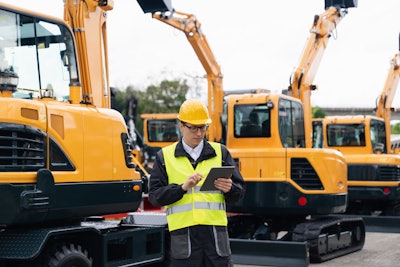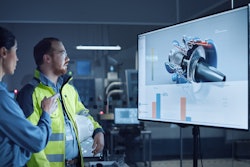
In 2024, original equipment manufacturers (OEMs) find themselves at the intersection of innovation and adaptation. As technology evolves and market demands shift, OEMs are facing a myriad trends and challenges that are shaping the landscape of the industry. From workplace culture to navigating the complexities of supply chain disruptions, construction equipment OEMs are charting a course through uncharted territory. With that in mind, let’s look at the trends and challenges that are defining the future of construction equipment manufacturing.
1. Turning to Gen Z to Help Workforce Challenges
The labor shortage is widespread across all industries, prompting employers to vie for talent from a limited pool. The challenge is not novel, yet companies grapple with devising innovative strategies to overcome it. Many turn to Gen Z, set to constitute a quarter of the workforce by 2025, necessitating a deliberate approach to attracting and retaining this younger generation.
While monetary factors matter to Gen Z, comprehending their core motivators is vital. To make the equipment manufacturing sector appealing, companies must underscore their commitment to corporate citizenship and carefully craft value statements, prominently featuring sustainability. Beyond environmentalism, sustainability encompasses waste reduction, a secure work environment, and community support.
Companies seeking to enhance their sustainable image should reevaluate mission, vision and core values for inclusivity and hiring impact. They should assess current sustainability efforts, leveraging technology for operational efficiency, encouraging employee volunteering, offering robust benefits and prioritizing workplace safety. Communicating these initiatives through social media and a sustainability-focused webpage is crucial.
Without it, companies risk facing increasing talent scarcity, particularly as baby boomers continue to exit the workforce in droves. Though results may not be immediate, investing time and effort upfront is worthwhile, given the impending demographic shifts.
2. R&D in Alternative Power
As the alternative power space evolves rapidly, many remain dedicated to staying informed, educating the industry, and fostering collaboration to ensure a seamless progression toward a future powered by alternative technologies.
In the heart of discussions about alternative power for construction lies diesel. According to the Diesel Technology Forum, 98% of U.S. construction energy use comes from diesel. With global efforts to achieve net-zero carbon emissions by 2050, construction manufacturers face the challenge of reducing diesel's carbon impact. Solutions include replacing diesel engines, running engines on lower-carbon fuels, and optimizing diesel engine efficiency.
The construction industry, with its diverse fleet and varied jobsites, explores alternatives such as electric, hydrogen, biodiesel and other biofuels.
Electric power is gaining momentum, offering zero emissions, low noise and comparable force to diesel. Despite challenges like limited run-time-per-charge and recharging time, electric options are expanding. However, there are ongoing concerns about power grids and how the rapid switch to electrical power across multiple sectors will make it difficult to manage these demands.
Hydrogen has also emerged as a viable alternative, particularly for larger machines. Construction equipment prototypes use hydrogen as a fuel cell or to power internal combustion engines. However, infrastructure challenges, such as limited hydrogen fueling stations, remain a concern.
Low-carbon fuels offer another avenue, modifying conventional engines to burn cleaner fuels. Companies are exploring fuel-agnostic engines, reducing emissions without significant changes to infrastructure or practices.
Diesel, despite its perception, remains a stalwart in construction. Tier 4 Final engines offer substantial emission reductions, and the gradual retirement of older machines contributes to lowering overall emissions. While alternative power solutions require patience and experimentation, government incentives and regulations play a crucial role. Achieving widespread adoption hinges on reaching a scale where economics align with sustainability goals.
In the pursuit of alternative power, the industry faces challenges in dealer service reconfigurations, technician training, and end user acceptance. As the construction sector navigates this evolving landscape, a global effort and a mix of solutions will shape the industry's future.
3. Supply Chain Management
In recent years, supply chain management has confronted various challenges, including a global pandemic, labor shortages and port congestion. As a result, organizations are redefining the concept of building a resilient supply chain to successfully navigate these challenges.
The digital transformation of organizations' supply chains has shifted to an industry standard. Organizations are actively digitizing their supply chains through automation and business intelligence, establishing master data management to aggregate information from the entire supply chain and external sources. The focus remains on pursuing greater automation and data-driven decision-making, leading to long-term cost savings, improved accuracy and faster processes.
With sustainability taking center stage amid new environmental, social and governance (ESG) regulations, organizations need to integrate ESG considerations throughout the supply chain, from raw material sourcing to product delivery. Sustainability is no longer just a means to satisfy end consumers and differentiate brands; it is now a regulatory requirement.
4. Changing Customer Expectations
More consumers than ever are standing up and saying, “I want to buy exclusively from sustainable companies.” Sustainability is becoming a major factor in purchasing decisions across the generational landscape. It’s a trend that’s expected to continue to grow over time.
Couple that notion with the need for e-commerce across all industries. The convenience, accessibility and transparency that the internet affords us in our everyday purchases has fundamentally changed expectations regarding how business is done.
This includes the digital transformation in the heavy equipment and parts industry, and it continues to accelerate. The stereotype of the “old school” customer should not define all customers in this industry. While some may fall into the late adopter category, the construction equipment industry is climbing the adoption curve on e-commerce and digital tools. Unlike other industries, the human element in the equipment transaction is vital.
According to the American Rental Association, equipment rental revenue, comprised of the construction/industrial and general tool segments, is expected to grow by 7.1 percent in 2024 to reach a record total of nearly $76.6 billion. The rental transaction for heavy equipment is complex and difficult without human intervention with most contractors having relationships with rental businesses and staying loyal because of familiarity.
Therefore, e-commerce in our industry is trending toward retention and enhancing existing customer relationships. All of this is to say salespeople have more time to find new business.
And those buyers are getting younger. According to a Merit study, up to 73% of all B2B buyers are now millennials. Millennials prefer to research and buy what they need online, and this is carrying over to business. As baby-boomer business owners pass their businesses on to the next generation, these buyers conduct research online first, meaning the digital representation of a business is now more important than how its operations look in person.
Everything from the company website to the reviews about the business to social media presence needs to be an accurate reflection of the business. It’s not enough to have a great website, it must be equally user friendly on mobile.
The equipment manufacturing sector stands at the intersection of transformative trends and formidable challenges, navigating an evolving landscape. As OEMs grapple with challenges and opportunities, they carve a path toward a future where efficiency, adaptability, and environmental consciousness converge. Through strategic foresight and collaborative endeavors, OEMs are not just meeting the demands of today but steering the course for a more robust and sustainable tomorrow.
John Somers is vice president, construction and utility sector, at the Association of Equipment Manufacturers (AEM). Sara Feuling is senior director, construction, at AEM.



















